Strategic Asset Management: Importance, Concepts, and Case Study Analysis
VerifiedAdded on 2022/11/18
|23
|4024
|228
AI Summary
This report discusses the importance of strategic asset management, concepts, and a critical analysis of a case study. It also includes the design and formulation of an appropriate strategic asset management plan. The case study analyzed is the Deepwater Horizon disaster in 2010. The report covers risk management, operations plan, and asset maintenance plan. The subject is Asset Management, Course Code: N/A, Course Name: N/A, College/University: N/A.
Contribute Materials
Your contribution can guide someone’s learning journey. Share your
documents today.
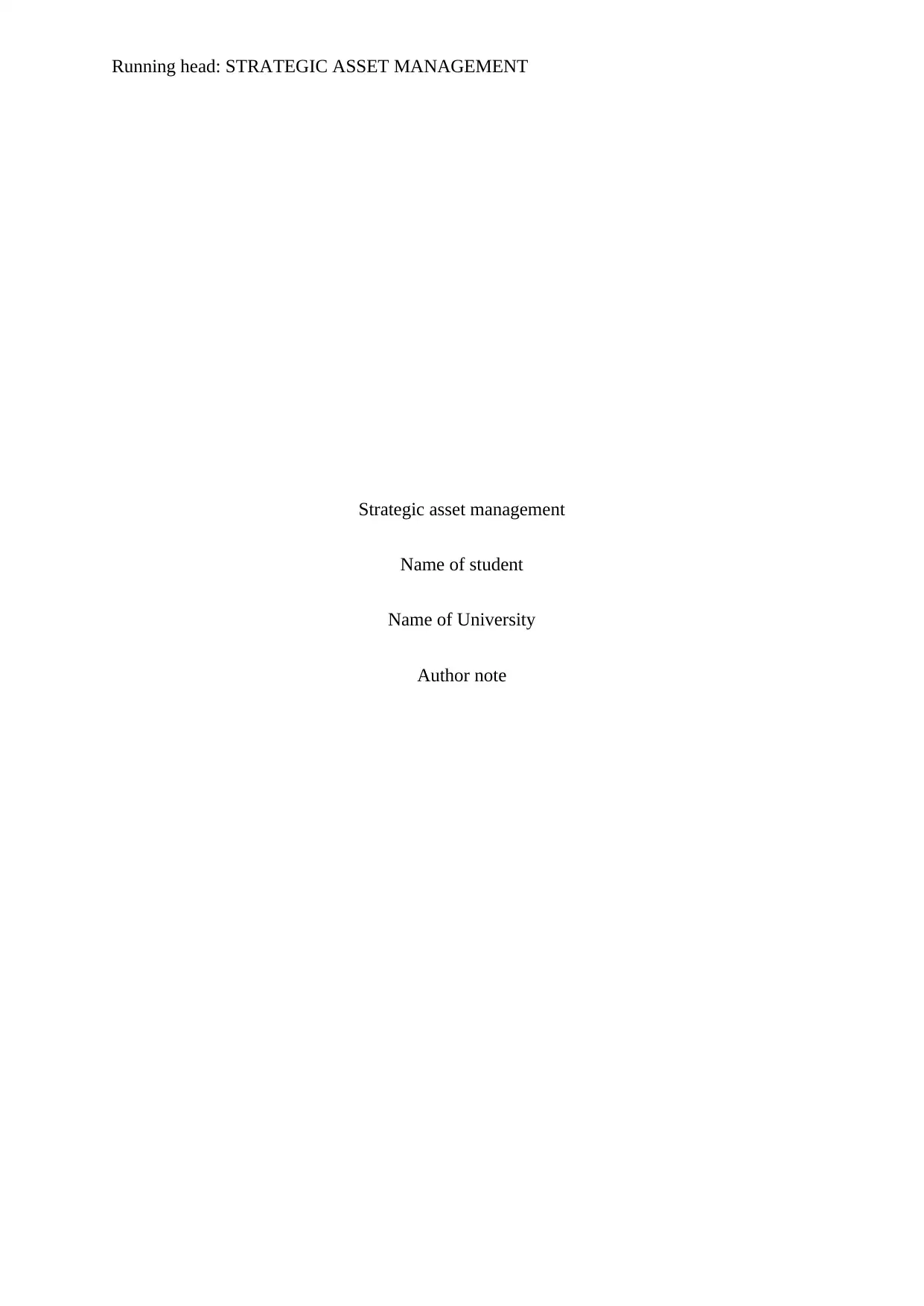
Running head: STRATEGIC ASSET MANAGEMENT
Strategic asset management
Name of student
Name of University
Author note
Strategic asset management
Name of student
Name of University
Author note
Secure Best Marks with AI Grader
Need help grading? Try our AI Grader for instant feedback on your assignments.
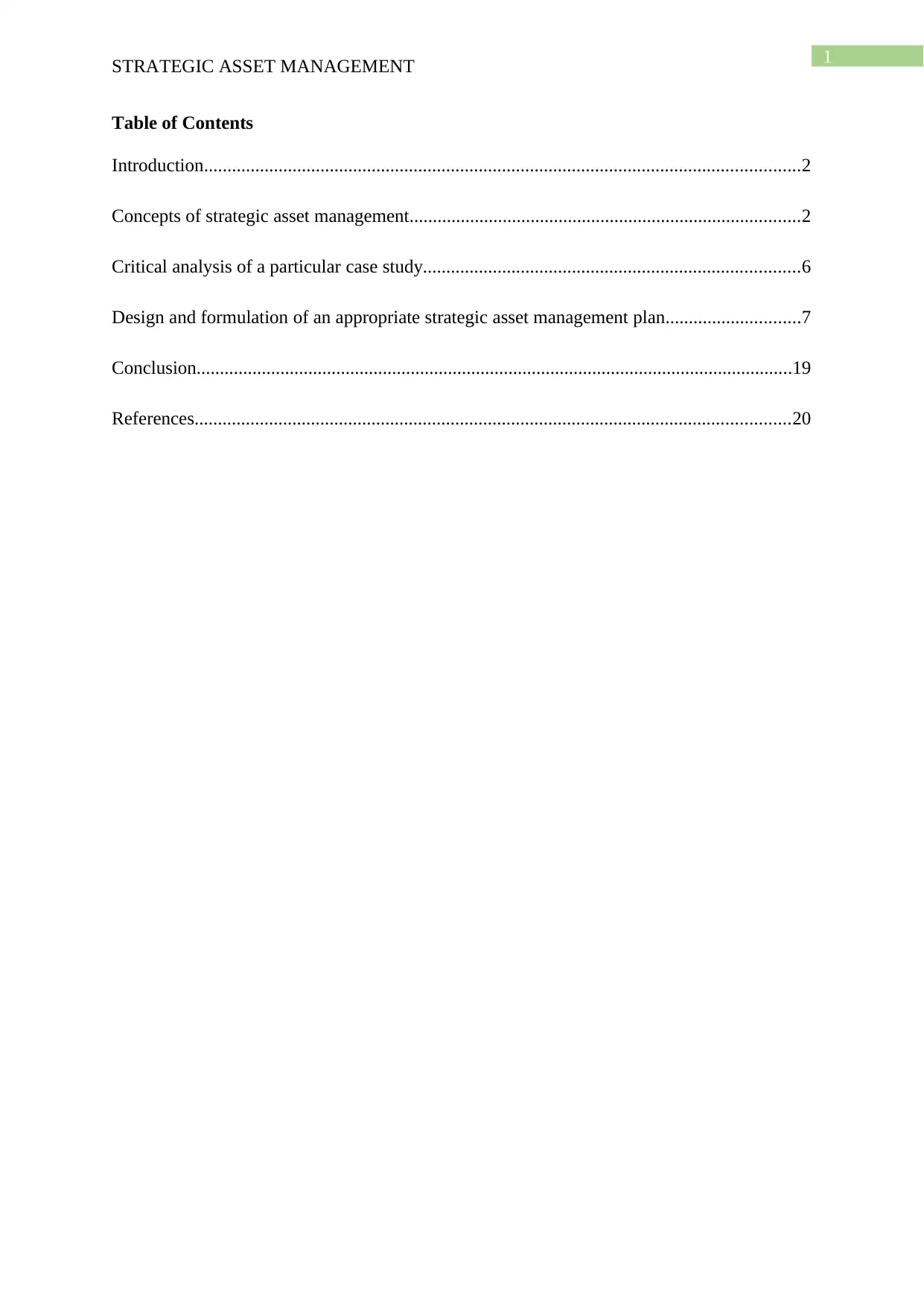
1
STRATEGIC ASSET MANAGEMENT
Table of Contents
Introduction................................................................................................................................2
Concepts of strategic asset management....................................................................................2
Critical analysis of a particular case study.................................................................................6
Design and formulation of an appropriate strategic asset management plan.............................7
Conclusion................................................................................................................................19
References................................................................................................................................20
STRATEGIC ASSET MANAGEMENT
Table of Contents
Introduction................................................................................................................................2
Concepts of strategic asset management....................................................................................2
Critical analysis of a particular case study.................................................................................6
Design and formulation of an appropriate strategic asset management plan.............................7
Conclusion................................................................................................................................19
References................................................................................................................................20

2
STRATEGIC ASSET MANAGEMENT
Introduction
The main purpose of this report is to highlight the importance of strategic asset
management considering the business organisation named British Petroleum. Based on the
strategic asset management perspective, the consideration of a disaster is done, which may
have resulted from the failure of asset management and this also affects the asset life cycle.
The failure of assets’ management can be experienced in the phase of requirements definition
and during the designing phase or operating phase, which may raise the chances of risks too.
It is of utmost importance to manage the risks and mitigate those for ensuring maintenance of
consistency all throughout the asset life cycle (El-Akruti, Dwight and Zhang 2016). A critical
analysis will also be done for the incident of Deep water Horizon disaster in the year 2010,
which can further help in developing various strategic asset management practices and ensure
meeting the business goals and objectives with ease and efficiency too.
Concepts of strategic asset management
According to Campbell, Jardine and McGlynn (2016), the assets that are possessed by
an organisation reflect the value that can be created along with the costs to be incurred and
management of value creation in the future too. The strategic asset management plan can also
allow the business organisations like British Petroleum or BP to prepare a comprehensive
disaster plan and ensure managing positive brand image, patents, trade, copyrights and
reputation too (Campbell, Jardine and McGlynn 2016). The strategic management of assets
also represents the management of assets in the form of investments on behalf of others
though with the purpose of mitigating the risks and ensure enhanced business performance.
As stated by El-Akruti, Dwight and Zhang (2013), the strategic asset management could also
be related to the investments that should be done for the products and enhancement of
services considering the organisation to face some major risks and disasters, just as it could
STRATEGIC ASSET MANAGEMENT
Introduction
The main purpose of this report is to highlight the importance of strategic asset
management considering the business organisation named British Petroleum. Based on the
strategic asset management perspective, the consideration of a disaster is done, which may
have resulted from the failure of asset management and this also affects the asset life cycle.
The failure of assets’ management can be experienced in the phase of requirements definition
and during the designing phase or operating phase, which may raise the chances of risks too.
It is of utmost importance to manage the risks and mitigate those for ensuring maintenance of
consistency all throughout the asset life cycle (El-Akruti, Dwight and Zhang 2016). A critical
analysis will also be done for the incident of Deep water Horizon disaster in the year 2010,
which can further help in developing various strategic asset management practices and ensure
meeting the business goals and objectives with ease and efficiency too.
Concepts of strategic asset management
According to Campbell, Jardine and McGlynn (2016), the assets that are possessed by
an organisation reflect the value that can be created along with the costs to be incurred and
management of value creation in the future too. The strategic asset management plan can also
allow the business organisations like British Petroleum or BP to prepare a comprehensive
disaster plan and ensure managing positive brand image, patents, trade, copyrights and
reputation too (Campbell, Jardine and McGlynn 2016). The strategic management of assets
also represents the management of assets in the form of investments on behalf of others
though with the purpose of mitigating the risks and ensure enhanced business performance.
As stated by El-Akruti, Dwight and Zhang (2013), the strategic asset management could also
be related to the investments that should be done for the products and enhancement of
services considering the organisation to face some major risks and disasters, just as it could

3
STRATEGIC ASSET MANAGEMENT
be found from the Deep water Horizon Incident in the year 2010. The concepts of the
strategic asset management involve managing both tangible and intangible assets and ensure
completion of the entire asset life cycle with much convenience and within quick time too
(El-Akruti, Dwight and Zhang 2013). The tangible assets of an organisation could be c where
the business can operate and various tools and techniques whereas the intangible assets or
entities should include the human resources, financial assets, working capital, brand image,
reputation and brand equity too (Campbell, Jardine and McGlynn 2016).
Figure: Asset management excellence pyramid (Campbell, Jardine and McGlynn
2016)
El-Akruti, Dwight and Zhang (2013) also stated that the strategic asset management
revolves around both the operational and strategic measurement programs, which should
assist in evaluating the changes to be done and at the same time, overcome the issues and
challenges that might have been posed by a disaster. The management of assets also has
STRATEGIC ASSET MANAGEMENT
be found from the Deep water Horizon Incident in the year 2010. The concepts of the
strategic asset management involve managing both tangible and intangible assets and ensure
completion of the entire asset life cycle with much convenience and within quick time too
(El-Akruti, Dwight and Zhang 2013). The tangible assets of an organisation could be c where
the business can operate and various tools and techniques whereas the intangible assets or
entities should include the human resources, financial assets, working capital, brand image,
reputation and brand equity too (Campbell, Jardine and McGlynn 2016).
Figure: Asset management excellence pyramid (Campbell, Jardine and McGlynn
2016)
El-Akruti, Dwight and Zhang (2013) also stated that the strategic asset management
revolves around both the operational and strategic measurement programs, which should
assist in evaluating the changes to be done and at the same time, overcome the issues and
challenges that might have been posed by a disaster. The management of assets also has
Secure Best Marks with AI Grader
Need help grading? Try our AI Grader for instant feedback on your assignments.
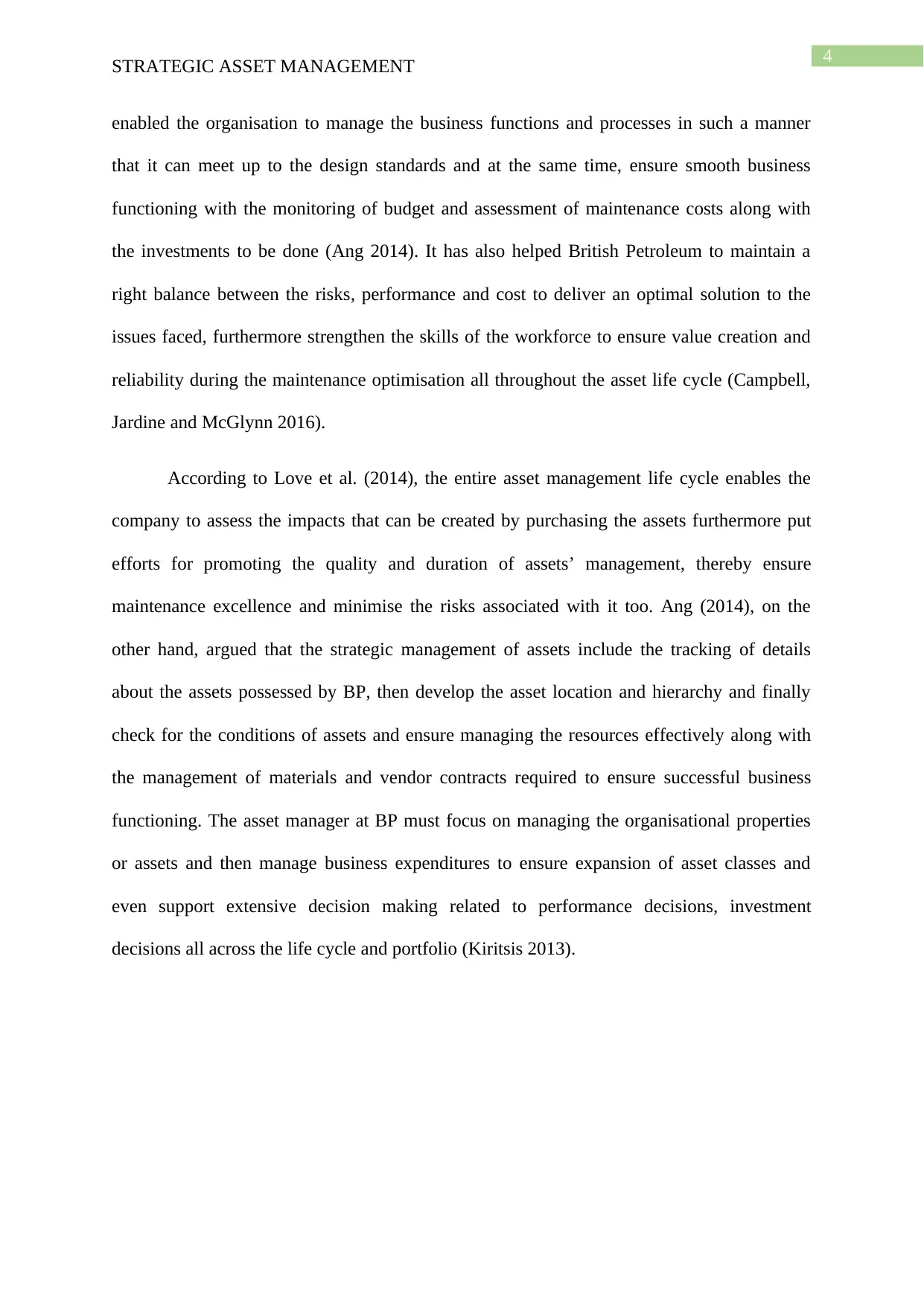
4
STRATEGIC ASSET MANAGEMENT
enabled the organisation to manage the business functions and processes in such a manner
that it can meet up to the design standards and at the same time, ensure smooth business
functioning with the monitoring of budget and assessment of maintenance costs along with
the investments to be done (Ang 2014). It has also helped British Petroleum to maintain a
right balance between the risks, performance and cost to deliver an optimal solution to the
issues faced, furthermore strengthen the skills of the workforce to ensure value creation and
reliability during the maintenance optimisation all throughout the asset life cycle (Campbell,
Jardine and McGlynn 2016).
According to Love et al. (2014), the entire asset management life cycle enables the
company to assess the impacts that can be created by purchasing the assets furthermore put
efforts for promoting the quality and duration of assets’ management, thereby ensure
maintenance excellence and minimise the risks associated with it too. Ang (2014), on the
other hand, argued that the strategic management of assets include the tracking of details
about the assets possessed by BP, then develop the asset location and hierarchy and finally
check for the conditions of assets and ensure managing the resources effectively along with
the management of materials and vendor contracts required to ensure successful business
functioning. The asset manager at BP must focus on managing the organisational properties
or assets and then manage business expenditures to ensure expansion of asset classes and
even support extensive decision making related to performance decisions, investment
decisions all across the life cycle and portfolio (Kiritsis 2013).
STRATEGIC ASSET MANAGEMENT
enabled the organisation to manage the business functions and processes in such a manner
that it can meet up to the design standards and at the same time, ensure smooth business
functioning with the monitoring of budget and assessment of maintenance costs along with
the investments to be done (Ang 2014). It has also helped British Petroleum to maintain a
right balance between the risks, performance and cost to deliver an optimal solution to the
issues faced, furthermore strengthen the skills of the workforce to ensure value creation and
reliability during the maintenance optimisation all throughout the asset life cycle (Campbell,
Jardine and McGlynn 2016).
According to Love et al. (2014), the entire asset management life cycle enables the
company to assess the impacts that can be created by purchasing the assets furthermore put
efforts for promoting the quality and duration of assets’ management, thereby ensure
maintenance excellence and minimise the risks associated with it too. Ang (2014), on the
other hand, argued that the strategic management of assets include the tracking of details
about the assets possessed by BP, then develop the asset location and hierarchy and finally
check for the conditions of assets and ensure managing the resources effectively along with
the management of materials and vendor contracts required to ensure successful business
functioning. The asset manager at BP must focus on managing the organisational properties
or assets and then manage business expenditures to ensure expansion of asset classes and
even support extensive decision making related to performance decisions, investment
decisions all across the life cycle and portfolio (Kiritsis 2013).
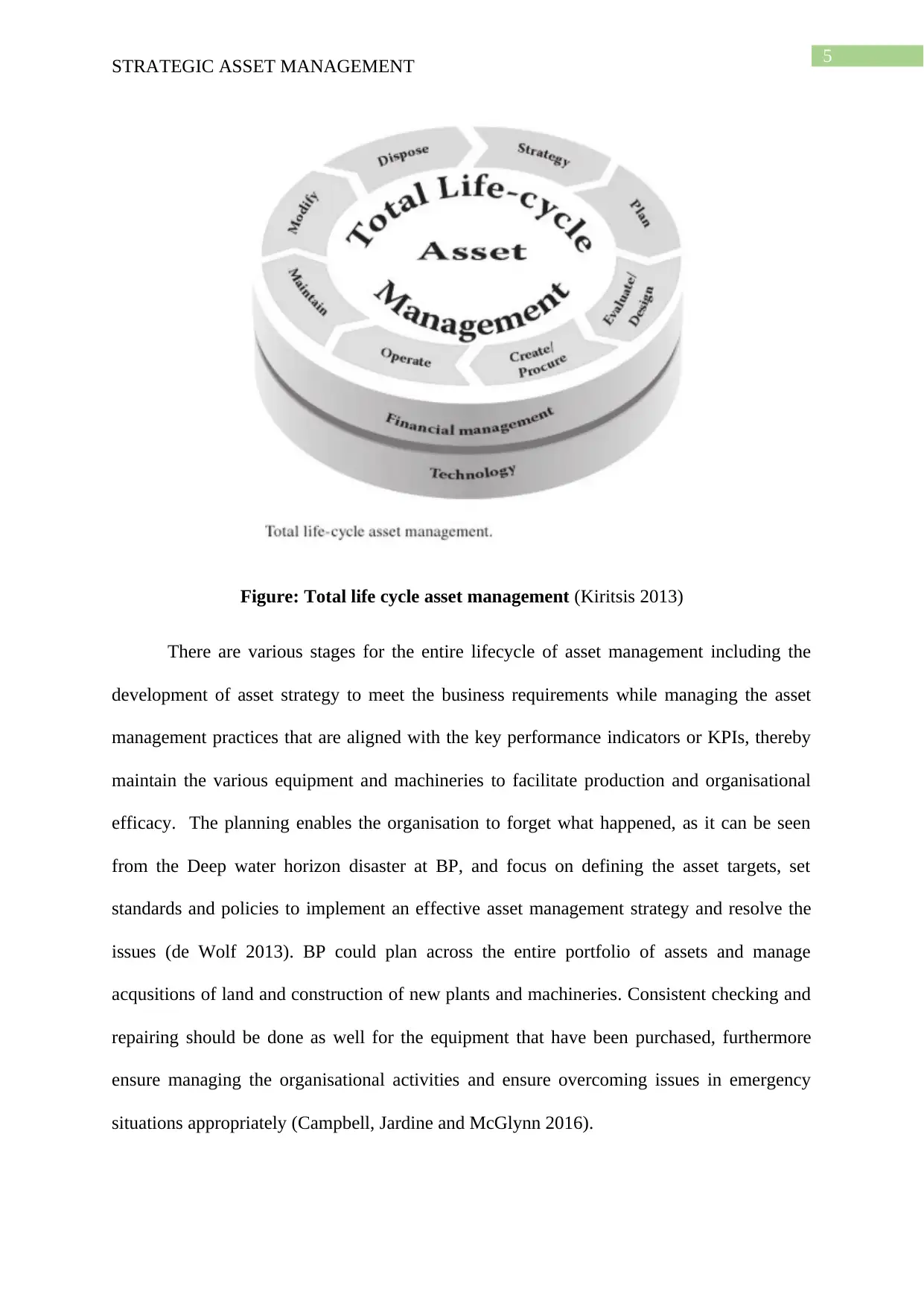
5
STRATEGIC ASSET MANAGEMENT
Figure: Total life cycle asset management (Kiritsis 2013)
There are various stages for the entire lifecycle of asset management including the
development of asset strategy to meet the business requirements while managing the asset
management practices that are aligned with the key performance indicators or KPIs, thereby
maintain the various equipment and machineries to facilitate production and organisational
efficacy. The planning enables the organisation to forget what happened, as it can be seen
from the Deep water horizon disaster at BP, and focus on defining the asset targets, set
standards and policies to implement an effective asset management strategy and resolve the
issues (de Wolf 2013). BP could plan across the entire portfolio of assets and manage
acqusitions of land and construction of new plants and machineries. Consistent checking and
repairing should be done as well for the equipment that have been purchased, furthermore
ensure managing the organisational activities and ensure overcoming issues in emergency
situations appropriately (Campbell, Jardine and McGlynn 2016).
STRATEGIC ASSET MANAGEMENT
Figure: Total life cycle asset management (Kiritsis 2013)
There are various stages for the entire lifecycle of asset management including the
development of asset strategy to meet the business requirements while managing the asset
management practices that are aligned with the key performance indicators or KPIs, thereby
maintain the various equipment and machineries to facilitate production and organisational
efficacy. The planning enables the organisation to forget what happened, as it can be seen
from the Deep water horizon disaster at BP, and focus on defining the asset targets, set
standards and policies to implement an effective asset management strategy and resolve the
issues (de Wolf 2013). BP could plan across the entire portfolio of assets and manage
acqusitions of land and construction of new plants and machineries. Consistent checking and
repairing should be done as well for the equipment that have been purchased, furthermore
ensure managing the organisational activities and ensure overcoming issues in emergency
situations appropriately (Campbell, Jardine and McGlynn 2016).
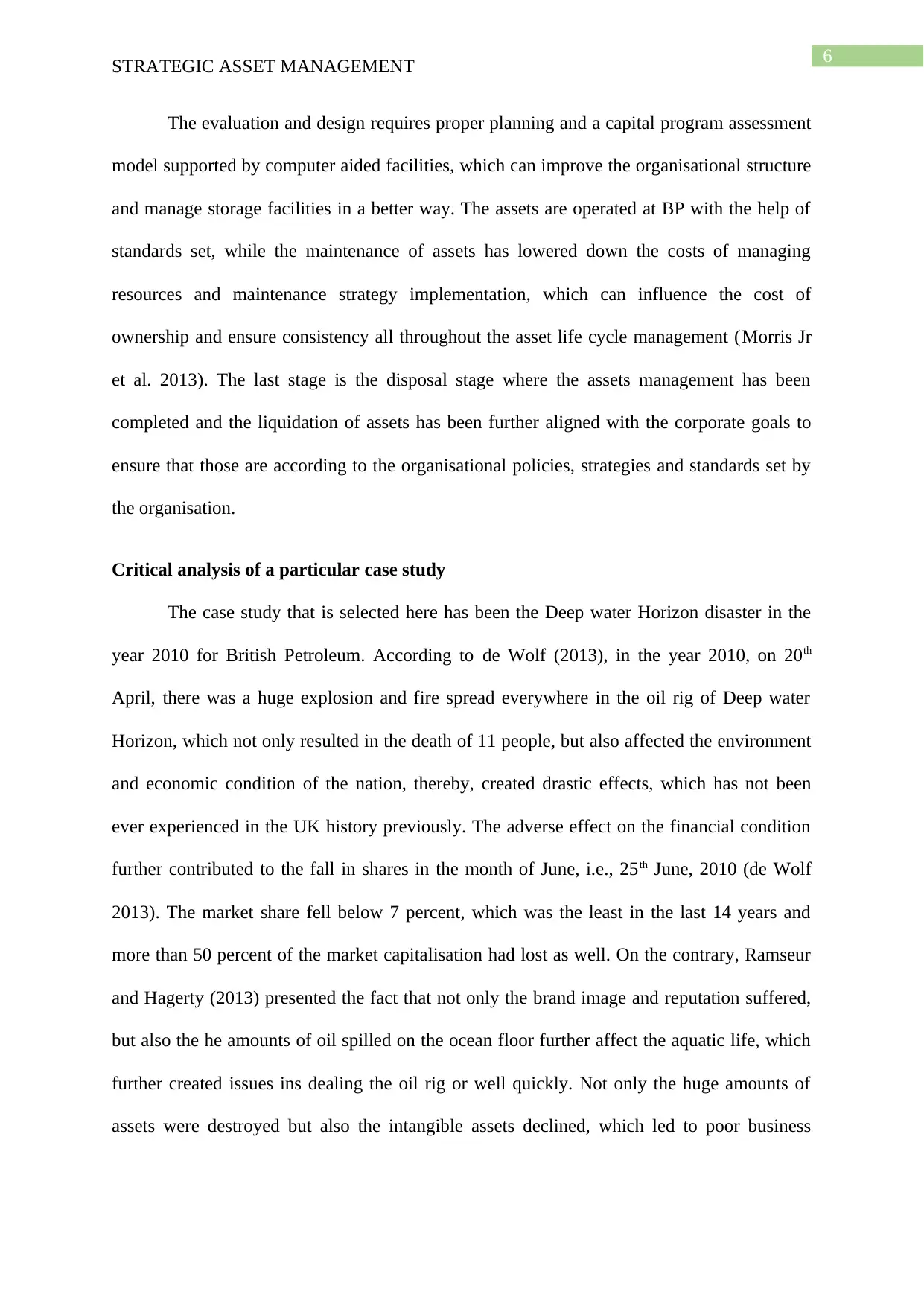
6
STRATEGIC ASSET MANAGEMENT
The evaluation and design requires proper planning and a capital program assessment
model supported by computer aided facilities, which can improve the organisational structure
and manage storage facilities in a better way. The assets are operated at BP with the help of
standards set, while the maintenance of assets has lowered down the costs of managing
resources and maintenance strategy implementation, which can influence the cost of
ownership and ensure consistency all throughout the asset life cycle management (Morris Jr
et al. 2013). The last stage is the disposal stage where the assets management has been
completed and the liquidation of assets has been further aligned with the corporate goals to
ensure that those are according to the organisational policies, strategies and standards set by
the organisation.
Critical analysis of a particular case study
The case study that is selected here has been the Deep water Horizon disaster in the
year 2010 for British Petroleum. According to de Wolf (2013), in the year 2010, on 20th
April, there was a huge explosion and fire spread everywhere in the oil rig of Deep water
Horizon, which not only resulted in the death of 11 people, but also affected the environment
and economic condition of the nation, thereby, created drastic effects, which has not been
ever experienced in the UK history previously. The adverse effect on the financial condition
further contributed to the fall in shares in the month of June, i.e., 25th June, 2010 (de Wolf
2013). The market share fell below 7 percent, which was the least in the last 14 years and
more than 50 percent of the market capitalisation had lost as well. On the contrary, Ramseur
and Hagerty (2013) presented the fact that not only the brand image and reputation suffered,
but also the he amounts of oil spilled on the ocean floor further affect the aquatic life, which
further created issues ins dealing the oil rig or well quickly. Not only the huge amounts of
assets were destroyed but also the intangible assets declined, which led to poor business
STRATEGIC ASSET MANAGEMENT
The evaluation and design requires proper planning and a capital program assessment
model supported by computer aided facilities, which can improve the organisational structure
and manage storage facilities in a better way. The assets are operated at BP with the help of
standards set, while the maintenance of assets has lowered down the costs of managing
resources and maintenance strategy implementation, which can influence the cost of
ownership and ensure consistency all throughout the asset life cycle management (Morris Jr
et al. 2013). The last stage is the disposal stage where the assets management has been
completed and the liquidation of assets has been further aligned with the corporate goals to
ensure that those are according to the organisational policies, strategies and standards set by
the organisation.
Critical analysis of a particular case study
The case study that is selected here has been the Deep water Horizon disaster in the
year 2010 for British Petroleum. According to de Wolf (2013), in the year 2010, on 20th
April, there was a huge explosion and fire spread everywhere in the oil rig of Deep water
Horizon, which not only resulted in the death of 11 people, but also affected the environment
and economic condition of the nation, thereby, created drastic effects, which has not been
ever experienced in the UK history previously. The adverse effect on the financial condition
further contributed to the fall in shares in the month of June, i.e., 25th June, 2010 (de Wolf
2013). The market share fell below 7 percent, which was the least in the last 14 years and
more than 50 percent of the market capitalisation had lost as well. On the contrary, Ramseur
and Hagerty (2013) presented the fact that not only the brand image and reputation suffered,
but also the he amounts of oil spilled on the ocean floor further affect the aquatic life, which
further created issues ins dealing the oil rig or well quickly. Not only the huge amounts of
assets were destroyed but also the intangible assets declined, which led to poor business
Paraphrase This Document
Need a fresh take? Get an instant paraphrase of this document with our AI Paraphraser
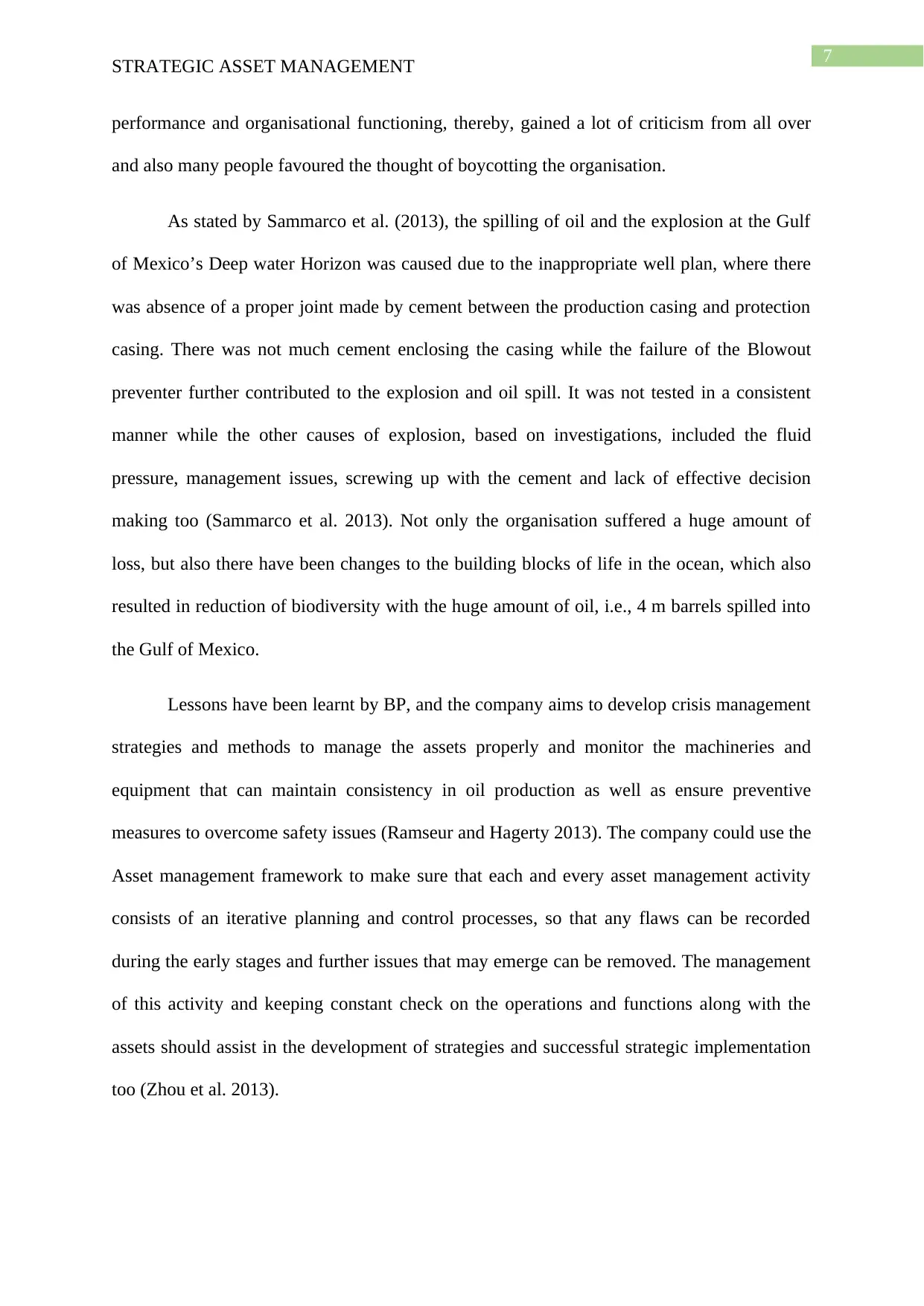
7
STRATEGIC ASSET MANAGEMENT
performance and organisational functioning, thereby, gained a lot of criticism from all over
and also many people favoured the thought of boycotting the organisation.
As stated by Sammarco et al. (2013), the spilling of oil and the explosion at the Gulf
of Mexico’s Deep water Horizon was caused due to the inappropriate well plan, where there
was absence of a proper joint made by cement between the production casing and protection
casing. There was not much cement enclosing the casing while the failure of the Blowout
preventer further contributed to the explosion and oil spill. It was not tested in a consistent
manner while the other causes of explosion, based on investigations, included the fluid
pressure, management issues, screwing up with the cement and lack of effective decision
making too (Sammarco et al. 2013). Not only the organisation suffered a huge amount of
loss, but also there have been changes to the building blocks of life in the ocean, which also
resulted in reduction of biodiversity with the huge amount of oil, i.e., 4 m barrels spilled into
the Gulf of Mexico.
Lessons have been learnt by BP, and the company aims to develop crisis management
strategies and methods to manage the assets properly and monitor the machineries and
equipment that can maintain consistency in oil production as well as ensure preventive
measures to overcome safety issues (Ramseur and Hagerty 2013). The company could use the
Asset management framework to make sure that each and every asset management activity
consists of an iterative planning and control processes, so that any flaws can be recorded
during the early stages and further issues that may emerge can be removed. The management
of this activity and keeping constant check on the operations and functions along with the
assets should assist in the development of strategies and successful strategic implementation
too (Zhou et al. 2013).
STRATEGIC ASSET MANAGEMENT
performance and organisational functioning, thereby, gained a lot of criticism from all over
and also many people favoured the thought of boycotting the organisation.
As stated by Sammarco et al. (2013), the spilling of oil and the explosion at the Gulf
of Mexico’s Deep water Horizon was caused due to the inappropriate well plan, where there
was absence of a proper joint made by cement between the production casing and protection
casing. There was not much cement enclosing the casing while the failure of the Blowout
preventer further contributed to the explosion and oil spill. It was not tested in a consistent
manner while the other causes of explosion, based on investigations, included the fluid
pressure, management issues, screwing up with the cement and lack of effective decision
making too (Sammarco et al. 2013). Not only the organisation suffered a huge amount of
loss, but also there have been changes to the building blocks of life in the ocean, which also
resulted in reduction of biodiversity with the huge amount of oil, i.e., 4 m barrels spilled into
the Gulf of Mexico.
Lessons have been learnt by BP, and the company aims to develop crisis management
strategies and methods to manage the assets properly and monitor the machineries and
equipment that can maintain consistency in oil production as well as ensure preventive
measures to overcome safety issues (Ramseur and Hagerty 2013). The company could use the
Asset management framework to make sure that each and every asset management activity
consists of an iterative planning and control processes, so that any flaws can be recorded
during the early stages and further issues that may emerge can be removed. The management
of this activity and keeping constant check on the operations and functions along with the
assets should assist in the development of strategies and successful strategic implementation
too (Zhou et al. 2013).
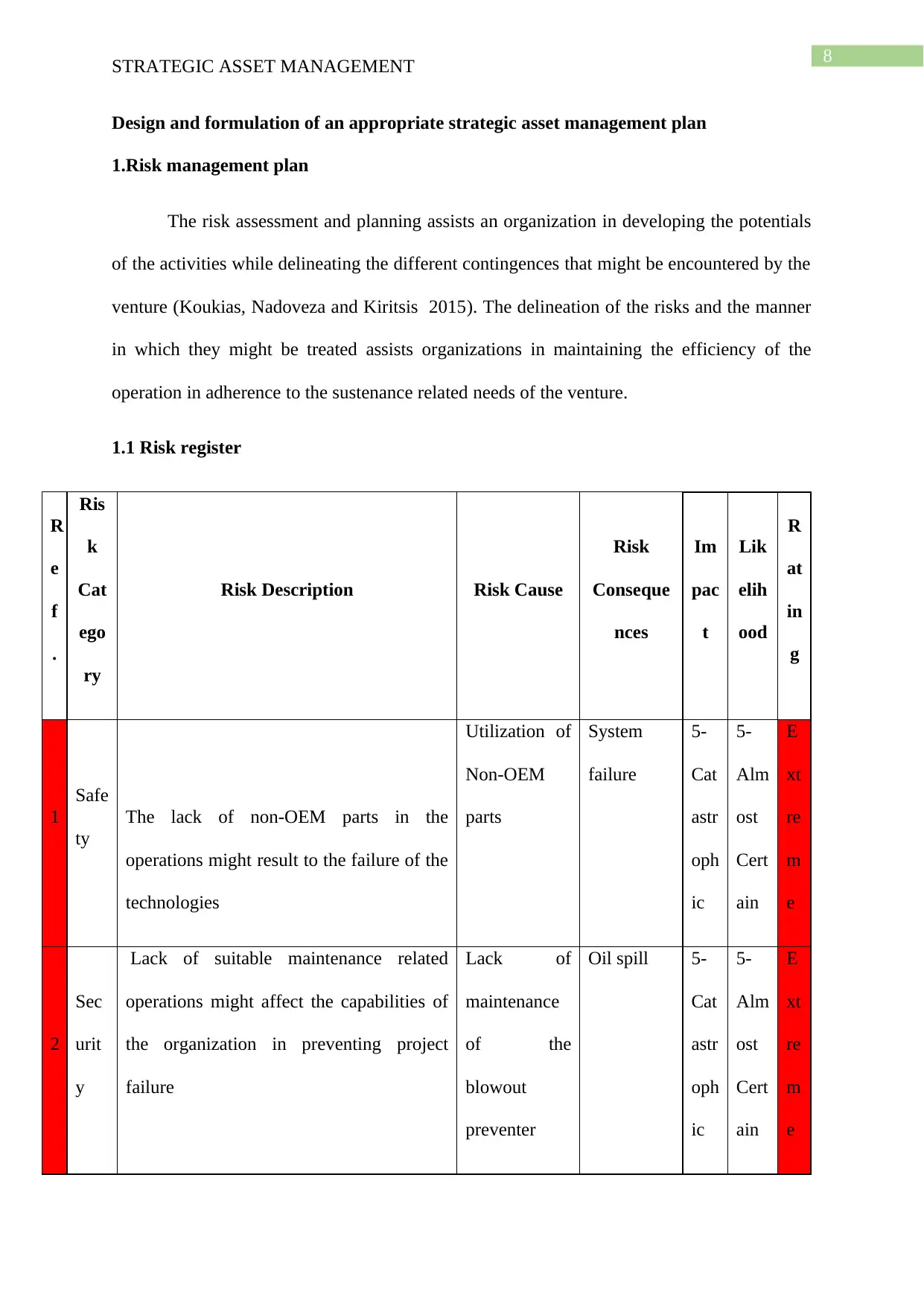
8
STRATEGIC ASSET MANAGEMENT
Design and formulation of an appropriate strategic asset management plan
1.Risk management plan
The risk assessment and planning assists an organization in developing the potentials
of the activities while delineating the different contingences that might be encountered by the
venture (Koukias, Nadoveza and Kiritsis 2015). The delineation of the risks and the manner
in which they might be treated assists organizations in maintaining the efficiency of the
operation in adherence to the sustenance related needs of the venture.
1.1 Risk register
R
e
f
.
Ris
k
Cat
ego
ry
Risk Description Risk Cause
Risk
Conseque
nces
Im
pac
t
Lik
elih
ood
R
at
in
g
1
Safe
ty
The lack of non-OEM parts in the
operations might result to the failure of the
technologies
Utilization of
Non-OEM
parts
System
failure
5-
Cat
astr
oph
ic
5-
Alm
ost
Cert
ain
E
xt
re
m
e
2
Sec
urit
y
Lack of suitable maintenance related
operations might affect the capabilities of
the organization in preventing project
failure
Lack of
maintenance
of the
blowout
preventer
Oil spill 5-
Cat
astr
oph
ic
5-
Alm
ost
Cert
ain
E
xt
re
m
e
STRATEGIC ASSET MANAGEMENT
Design and formulation of an appropriate strategic asset management plan
1.Risk management plan
The risk assessment and planning assists an organization in developing the potentials
of the activities while delineating the different contingences that might be encountered by the
venture (Koukias, Nadoveza and Kiritsis 2015). The delineation of the risks and the manner
in which they might be treated assists organizations in maintaining the efficiency of the
operation in adherence to the sustenance related needs of the venture.
1.1 Risk register
R
e
f
.
Ris
k
Cat
ego
ry
Risk Description Risk Cause
Risk
Conseque
nces
Im
pac
t
Lik
elih
ood
R
at
in
g
1
Safe
ty
The lack of non-OEM parts in the
operations might result to the failure of the
technologies
Utilization of
Non-OEM
parts
System
failure
5-
Cat
astr
oph
ic
5-
Alm
ost
Cert
ain
E
xt
re
m
e
2
Sec
urit
y
Lack of suitable maintenance related
operations might affect the capabilities of
the organization in preventing project
failure
Lack of
maintenance
of the
blowout
preventer
Oil spill 5-
Cat
astr
oph
ic
5-
Alm
ost
Cert
ain
E
xt
re
m
e
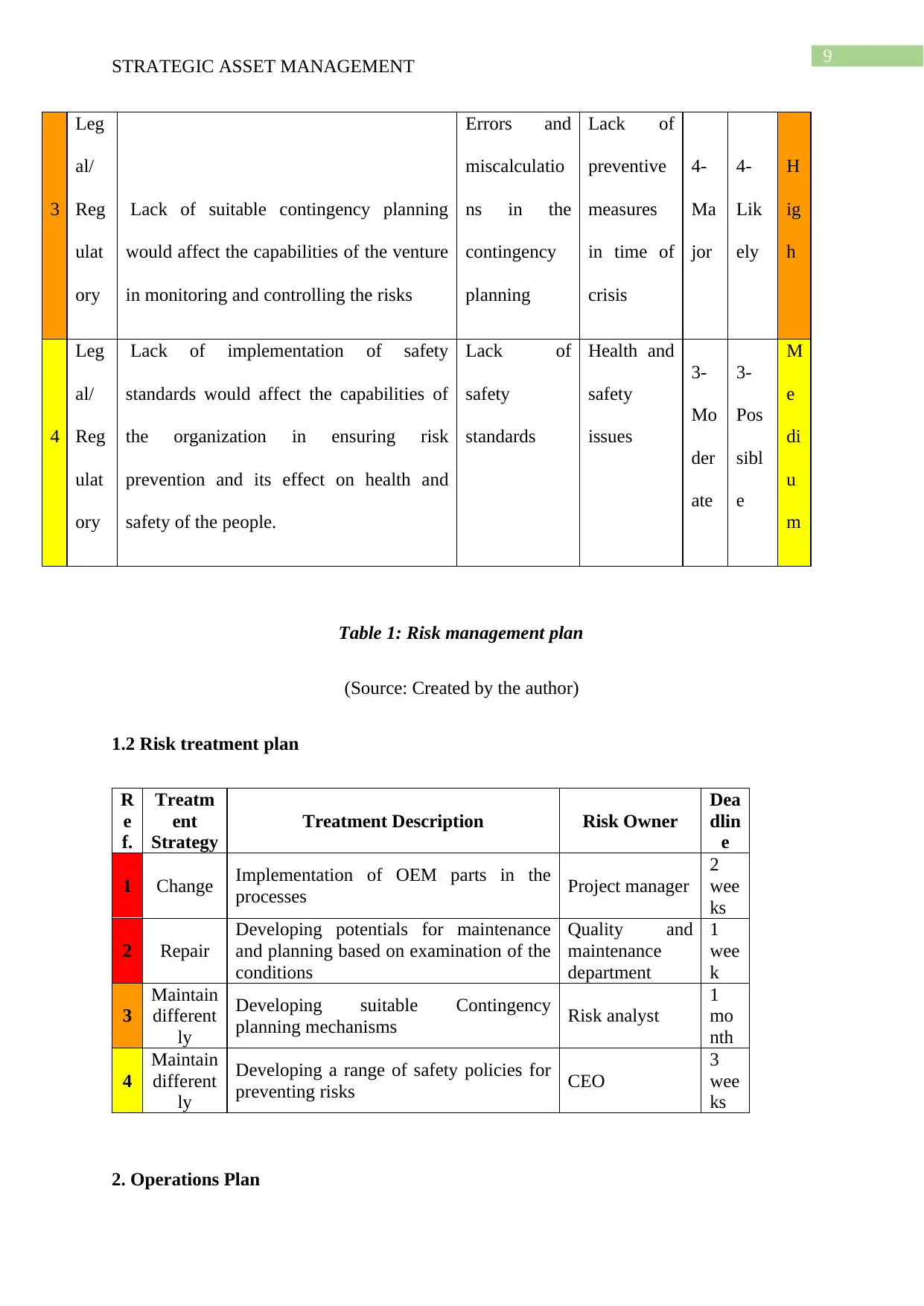
9
STRATEGIC ASSET MANAGEMENT
3
Leg
al/
Reg
ulat
ory
Lack of suitable contingency planning
would affect the capabilities of the venture
in monitoring and controlling the risks
Errors and
miscalculatio
ns in the
contingency
planning
Lack of
preventive
measures
in time of
crisis
4-
Ma
jor
4-
Lik
ely
H
ig
h
4
Leg
al/
Reg
ulat
ory
Lack of implementation of safety
standards would affect the capabilities of
the organization in ensuring risk
prevention and its effect on health and
safety of the people.
Lack of
safety
standards
Health and
safety
issues
3-
Mo
der
ate
3-
Pos
sibl
e
M
e
di
u
m
Table 1: Risk management plan
(Source: Created by the author)
1.2 Risk treatment plan
R
e
f.
Treatm
ent
Strategy
Treatment Description Risk Owner
Dea
dlin
e
1 Change Implementation of OEM parts in the
processes Project manager
2
wee
ks
2 Repair
Developing potentials for maintenance
and planning based on examination of the
conditions
Quality and
maintenance
department
1
wee
k
3
Maintain
different
ly
Developing suitable Contingency
planning mechanisms Risk analyst
1
mo
nth
4
Maintain
different
ly
Developing a range of safety policies for
preventing risks CEO
3
wee
ks
2. Operations Plan
STRATEGIC ASSET MANAGEMENT
3
Leg
al/
Reg
ulat
ory
Lack of suitable contingency planning
would affect the capabilities of the venture
in monitoring and controlling the risks
Errors and
miscalculatio
ns in the
contingency
planning
Lack of
preventive
measures
in time of
crisis
4-
Ma
jor
4-
Lik
ely
H
ig
h
4
Leg
al/
Reg
ulat
ory
Lack of implementation of safety
standards would affect the capabilities of
the organization in ensuring risk
prevention and its effect on health and
safety of the people.
Lack of
safety
standards
Health and
safety
issues
3-
Mo
der
ate
3-
Pos
sibl
e
M
e
di
u
m
Table 1: Risk management plan
(Source: Created by the author)
1.2 Risk treatment plan
R
e
f.
Treatm
ent
Strategy
Treatment Description Risk Owner
Dea
dlin
e
1 Change Implementation of OEM parts in the
processes Project manager
2
wee
ks
2 Repair
Developing potentials for maintenance
and planning based on examination of the
conditions
Quality and
maintenance
department
1
wee
k
3
Maintain
different
ly
Developing suitable Contingency
planning mechanisms Risk analyst
1
mo
nth
4
Maintain
different
ly
Developing a range of safety policies for
preventing risks CEO
3
wee
ks
2. Operations Plan
Secure Best Marks with AI Grader
Need help grading? Try our AI Grader for instant feedback on your assignments.
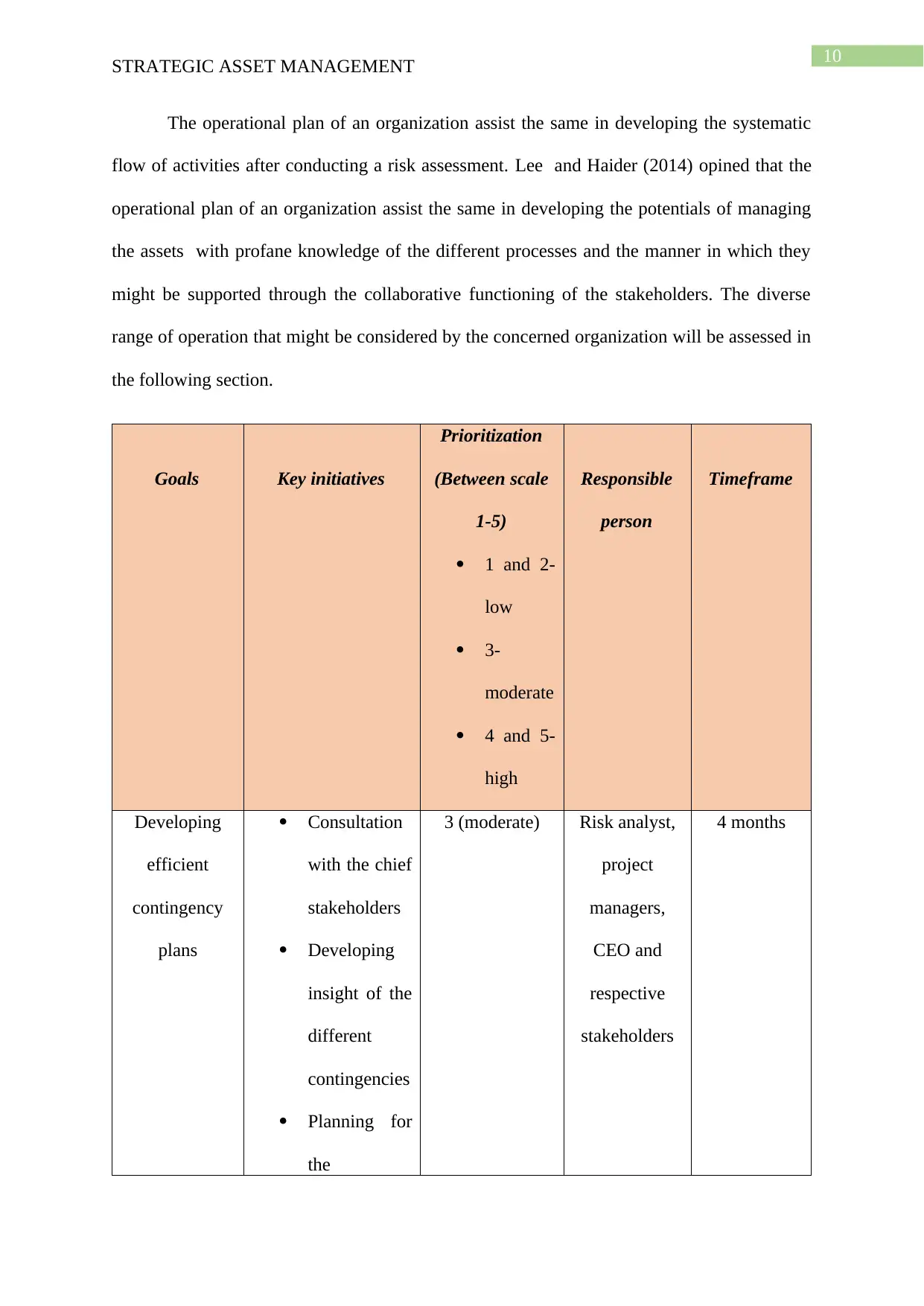
10
STRATEGIC ASSET MANAGEMENT
The operational plan of an organization assist the same in developing the systematic
flow of activities after conducting a risk assessment. Lee and Haider (2014) opined that the
operational plan of an organization assist the same in developing the potentials of managing
the assets with profane knowledge of the different processes and the manner in which they
might be supported through the collaborative functioning of the stakeholders. The diverse
range of operation that might be considered by the concerned organization will be assessed in
the following section.
Goals Key initiatives
Prioritization
(Between scale
1-5)
1 and 2-
low
3-
moderate
4 and 5-
high
Responsible
person
Timeframe
Developing
efficient
contingency
plans
Consultation
with the chief
stakeholders
Developing
insight of the
different
contingencies
Planning for
the
3 (moderate) Risk analyst,
project
managers,
CEO and
respective
stakeholders
4 months
STRATEGIC ASSET MANAGEMENT
The operational plan of an organization assist the same in developing the systematic
flow of activities after conducting a risk assessment. Lee and Haider (2014) opined that the
operational plan of an organization assist the same in developing the potentials of managing
the assets with profane knowledge of the different processes and the manner in which they
might be supported through the collaborative functioning of the stakeholders. The diverse
range of operation that might be considered by the concerned organization will be assessed in
the following section.
Goals Key initiatives
Prioritization
(Between scale
1-5)
1 and 2-
low
3-
moderate
4 and 5-
high
Responsible
person
Timeframe
Developing
efficient
contingency
plans
Consultation
with the chief
stakeholders
Developing
insight of the
different
contingencies
Planning for
the
3 (moderate) Risk analyst,
project
managers,
CEO and
respective
stakeholders
4 months

11
STRATEGIC ASSET MANAGEMENT
contingencies
Implementing
suitable OEM
parts
Monitoring
the need of
OEMs in the
process
design
Consultation
with different
stakeholders
Budgetary
activities
Undertaking
partnership
with the
OEM
suppliers
Implementin
g the OEMs
5 (major) Accounts
manager,
Project
managers,
OEM
suppliers,
relevant
stakeholders,
Board of
directors
6 months
Developing a
culture of
continuous
monitoring and
maintenance of
the assets
Consultation
with the
stakeholders
Developing
insight on the
needs of asset
monitoring
4 (major) Maintenance
companies,
project
managers,
other
stakeholders
6 months
STRATEGIC ASSET MANAGEMENT
contingencies
Implementing
suitable OEM
parts
Monitoring
the need of
OEMs in the
process
design
Consultation
with different
stakeholders
Budgetary
activities
Undertaking
partnership
with the
OEM
suppliers
Implementin
g the OEMs
5 (major) Accounts
manager,
Project
managers,
OEM
suppliers,
relevant
stakeholders,
Board of
directors
6 months
Developing a
culture of
continuous
monitoring and
maintenance of
the assets
Consultation
with the
stakeholders
Developing
insight on the
needs of asset
monitoring
4 (major) Maintenance
companies,
project
managers,
other
stakeholders
6 months
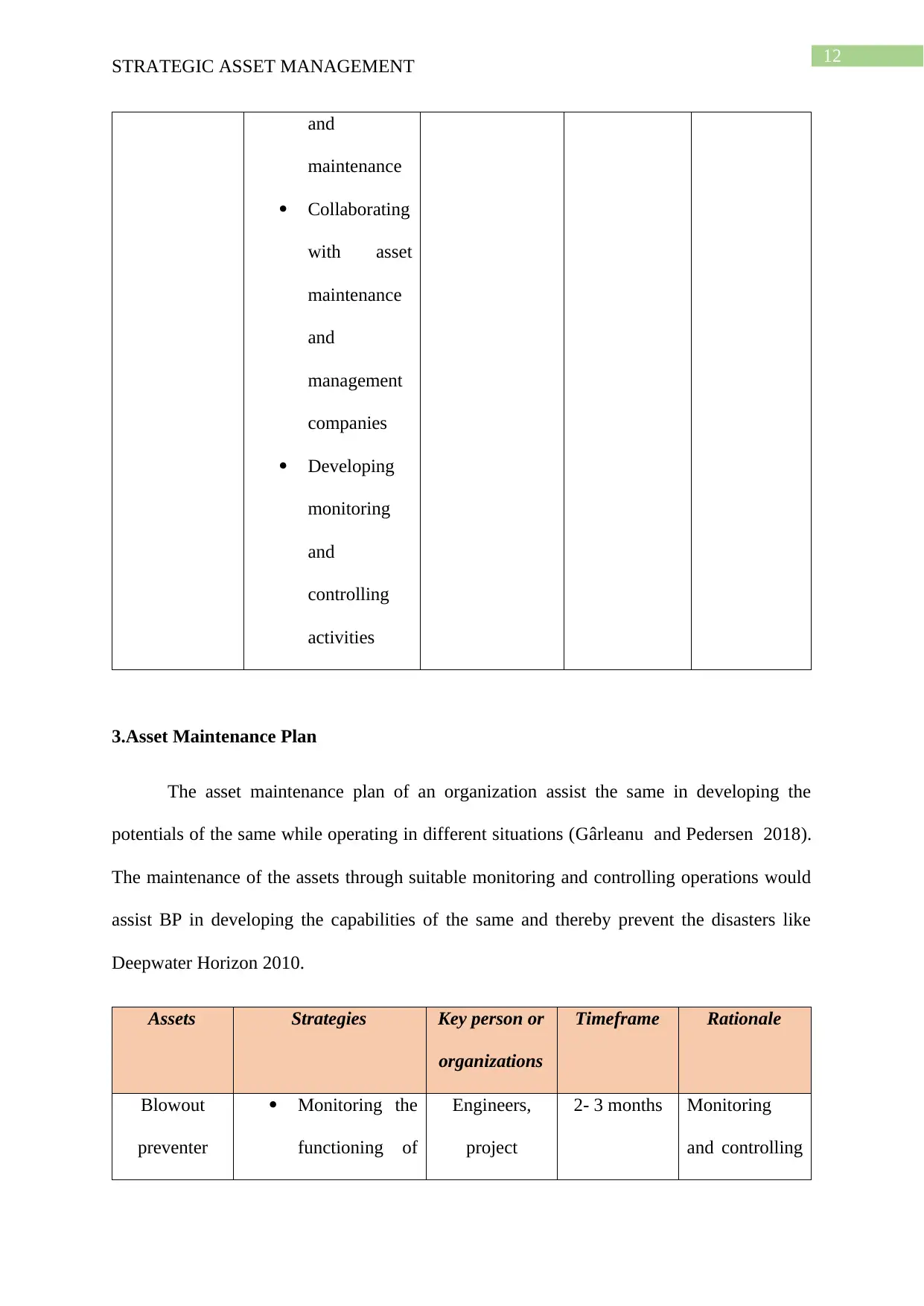
12
STRATEGIC ASSET MANAGEMENT
and
maintenance
Collaborating
with asset
maintenance
and
management
companies
Developing
monitoring
and
controlling
activities
3.Asset Maintenance Plan
The asset maintenance plan of an organization assist the same in developing the
potentials of the same while operating in different situations (Gârleanu and Pedersen 2018).
The maintenance of the assets through suitable monitoring and controlling operations would
assist BP in developing the capabilities of the same and thereby prevent the disasters like
Deepwater Horizon 2010.
Assets Strategies Key person or
organizations
Timeframe Rationale
Blowout
preventer
Monitoring the
functioning of
Engineers,
project
2- 3 months Monitoring
and controlling
STRATEGIC ASSET MANAGEMENT
and
maintenance
Collaborating
with asset
maintenance
and
management
companies
Developing
monitoring
and
controlling
activities
3.Asset Maintenance Plan
The asset maintenance plan of an organization assist the same in developing the
potentials of the same while operating in different situations (Gârleanu and Pedersen 2018).
The maintenance of the assets through suitable monitoring and controlling operations would
assist BP in developing the capabilities of the same and thereby prevent the disasters like
Deepwater Horizon 2010.
Assets Strategies Key person or
organizations
Timeframe Rationale
Blowout
preventer
Monitoring the
functioning of
Engineers,
project
2- 3 months Monitoring
and controlling
Paraphrase This Document
Need a fresh take? Get an instant paraphrase of this document with our AI Paraphraser
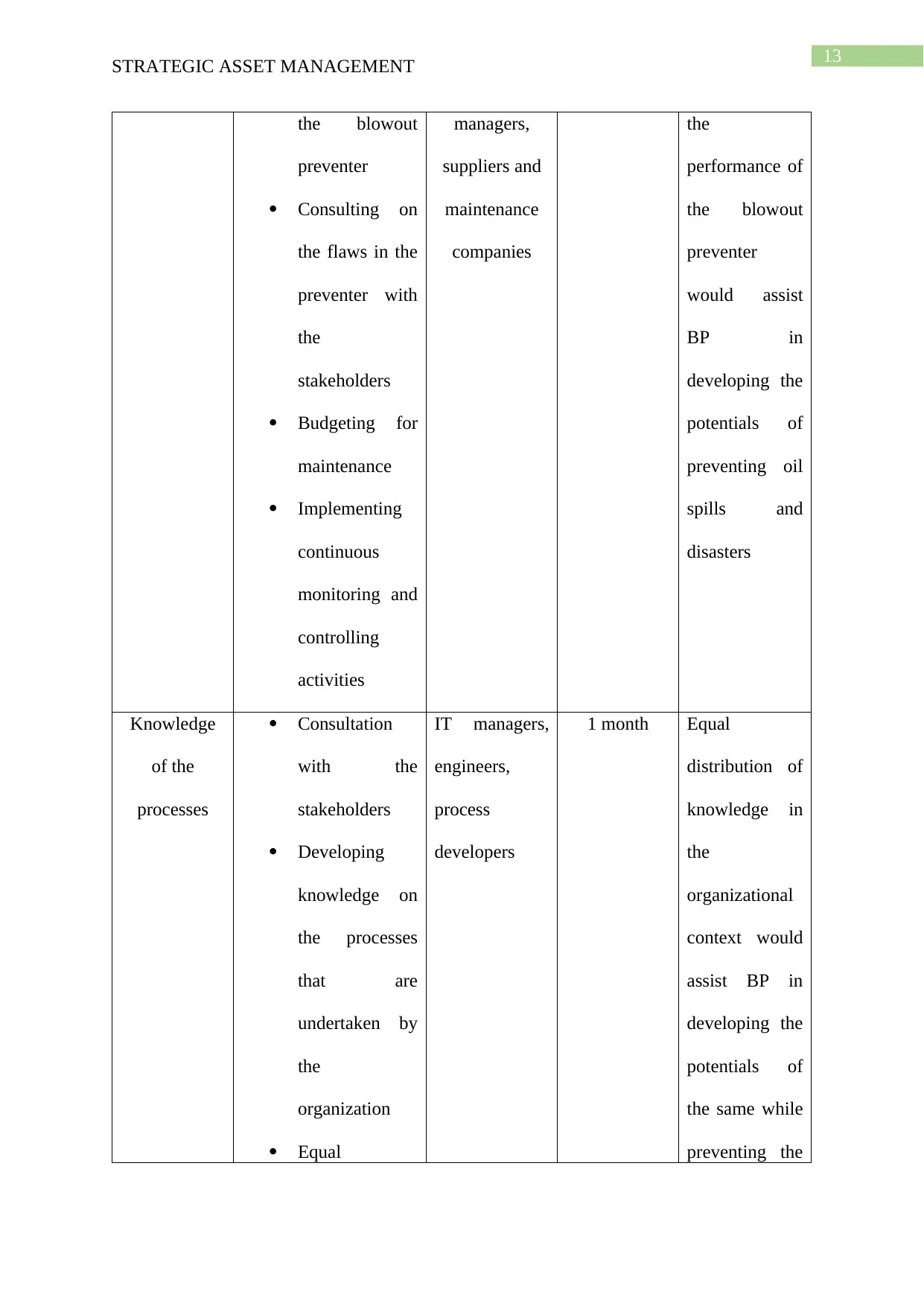
13
STRATEGIC ASSET MANAGEMENT
the blowout
preventer
Consulting on
the flaws in the
preventer with
the
stakeholders
Budgeting for
maintenance
Implementing
continuous
monitoring and
controlling
activities
managers,
suppliers and
maintenance
companies
the
performance of
the blowout
preventer
would assist
BP in
developing the
potentials of
preventing oil
spills and
disasters
Knowledge
of the
processes
Consultation
with the
stakeholders
Developing
knowledge on
the processes
that are
undertaken by
the
organization
Equal
IT managers,
engineers,
process
developers
1 month Equal
distribution of
knowledge in
the
organizational
context would
assist BP in
developing the
potentials of
the same while
preventing the
STRATEGIC ASSET MANAGEMENT
the blowout
preventer
Consulting on
the flaws in the
preventer with
the
stakeholders
Budgeting for
maintenance
Implementing
continuous
monitoring and
controlling
activities
managers,
suppliers and
maintenance
companies
the
performance of
the blowout
preventer
would assist
BP in
developing the
potentials of
preventing oil
spills and
disasters
Knowledge
of the
processes
Consultation
with the
stakeholders
Developing
knowledge on
the processes
that are
undertaken by
the
organization
Equal
IT managers,
engineers,
process
developers
1 month Equal
distribution of
knowledge in
the
organizational
context would
assist BP in
developing the
potentials of
the same while
preventing the

14
STRATEGIC ASSET MANAGEMENT
distribution of
knowledge
among the
stakeholders for
the smooth
functioning of
the systems
catastrophic
risks. O the
other hand, the
equal
distribution of
the knowledge
among the
stakeholders
would assist
BP in
developing
transparency in
the reporting
attributes for
suitable
contingency
planning
Structure of
the oil
storage
Communication
among the
stakeholders
like
maintenance
agents and oil
storage
developers
Engineers,
maintenance
companies,
project
managers
3 months Developing the
structure of the
rigs would
assist BP in
preventing
future disasters
STRATEGIC ASSET MANAGEMENT
distribution of
knowledge
among the
stakeholders for
the smooth
functioning of
the systems
catastrophic
risks. O the
other hand, the
equal
distribution of
the knowledge
among the
stakeholders
would assist
BP in
developing
transparency in
the reporting
attributes for
suitable
contingency
planning
Structure of
the oil
storage
Communication
among the
stakeholders
like
maintenance
agents and oil
storage
developers
Engineers,
maintenance
companies,
project
managers
3 months Developing the
structure of the
rigs would
assist BP in
preventing
future disasters
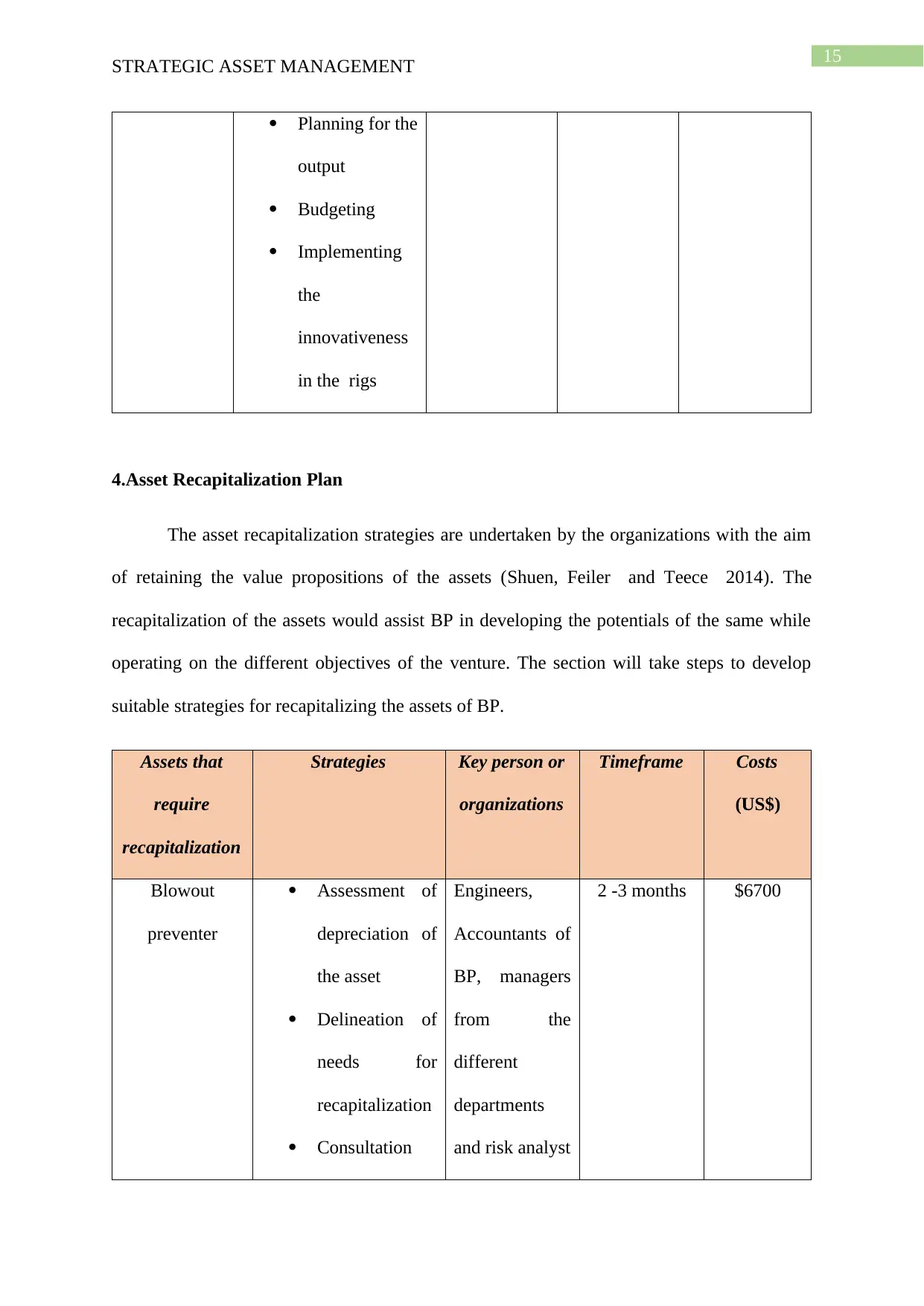
15
STRATEGIC ASSET MANAGEMENT
Planning for the
output
Budgeting
Implementing
the
innovativeness
in the rigs
4.Asset Recapitalization Plan
The asset recapitalization strategies are undertaken by the organizations with the aim
of retaining the value propositions of the assets (Shuen, Feiler and Teece 2014). The
recapitalization of the assets would assist BP in developing the potentials of the same while
operating on the different objectives of the venture. The section will take steps to develop
suitable strategies for recapitalizing the assets of BP.
Assets that
require
recapitalization
Strategies Key person or
organizations
Timeframe Costs
(US$)
Blowout
preventer
Assessment of
depreciation of
the asset
Delineation of
needs for
recapitalization
Consultation
Engineers,
Accountants of
BP, managers
from the
different
departments
and risk analyst
2 -3 months $6700
STRATEGIC ASSET MANAGEMENT
Planning for the
output
Budgeting
Implementing
the
innovativeness
in the rigs
4.Asset Recapitalization Plan
The asset recapitalization strategies are undertaken by the organizations with the aim
of retaining the value propositions of the assets (Shuen, Feiler and Teece 2014). The
recapitalization of the assets would assist BP in developing the potentials of the same while
operating on the different objectives of the venture. The section will take steps to develop
suitable strategies for recapitalizing the assets of BP.
Assets that
require
recapitalization
Strategies Key person or
organizations
Timeframe Costs
(US$)
Blowout
preventer
Assessment of
depreciation of
the asset
Delineation of
needs for
recapitalization
Consultation
Engineers,
Accountants of
BP, managers
from the
different
departments
and risk analyst
2 -3 months $6700
Secure Best Marks with AI Grader
Need help grading? Try our AI Grader for instant feedback on your assignments.
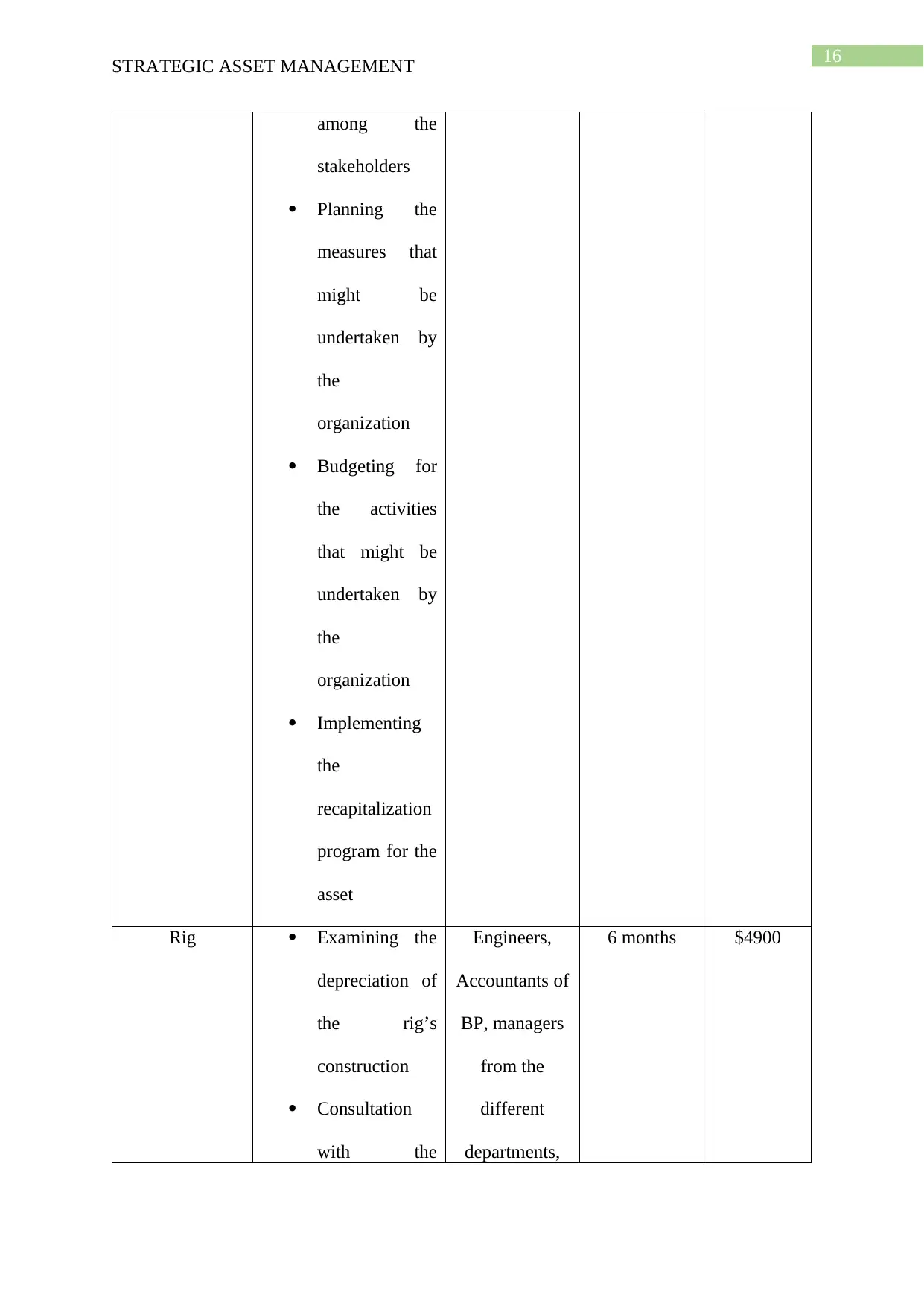
16
STRATEGIC ASSET MANAGEMENT
among the
stakeholders
Planning the
measures that
might be
undertaken by
the
organization
Budgeting for
the activities
that might be
undertaken by
the
organization
Implementing
the
recapitalization
program for the
asset
Rig Examining the
depreciation of
the rig’s
construction
Consultation
with the
Engineers,
Accountants of
BP, managers
from the
different
departments,
6 months $4900
STRATEGIC ASSET MANAGEMENT
among the
stakeholders
Planning the
measures that
might be
undertaken by
the
organization
Budgeting for
the activities
that might be
undertaken by
the
organization
Implementing
the
recapitalization
program for the
asset
Rig Examining the
depreciation of
the rig’s
construction
Consultation
with the
Engineers,
Accountants of
BP, managers
from the
different
departments,
6 months $4900

17
STRATEGIC ASSET MANAGEMENT
maintenance
agencies
Planning for the
remodeling and
the resources
that might be
required for the
same
Creating
Budgets for the
estimated
activities
Remodeling the
rigs through
issuing suitable
financial assets
the
maintenance
companies and
risk analyst
OEMs Assessing the
state of
depreciation of
the OEMs in
the project
Communication
with the OEM
part suppliers
Framing budget
Engineers,
Accountants of
BP, managers
from the
different
departments,
suppliers of the
OEMs and risk
analyst
6- 8 months $9600
STRATEGIC ASSET MANAGEMENT
maintenance
agencies
Planning for the
remodeling and
the resources
that might be
required for the
same
Creating
Budgets for the
estimated
activities
Remodeling the
rigs through
issuing suitable
financial assets
the
maintenance
companies and
risk analyst
OEMs Assessing the
state of
depreciation of
the OEMs in
the project
Communication
with the OEM
part suppliers
Framing budget
Engineers,
Accountants of
BP, managers
from the
different
departments,
suppliers of the
OEMs and risk
analyst
6- 8 months $9600
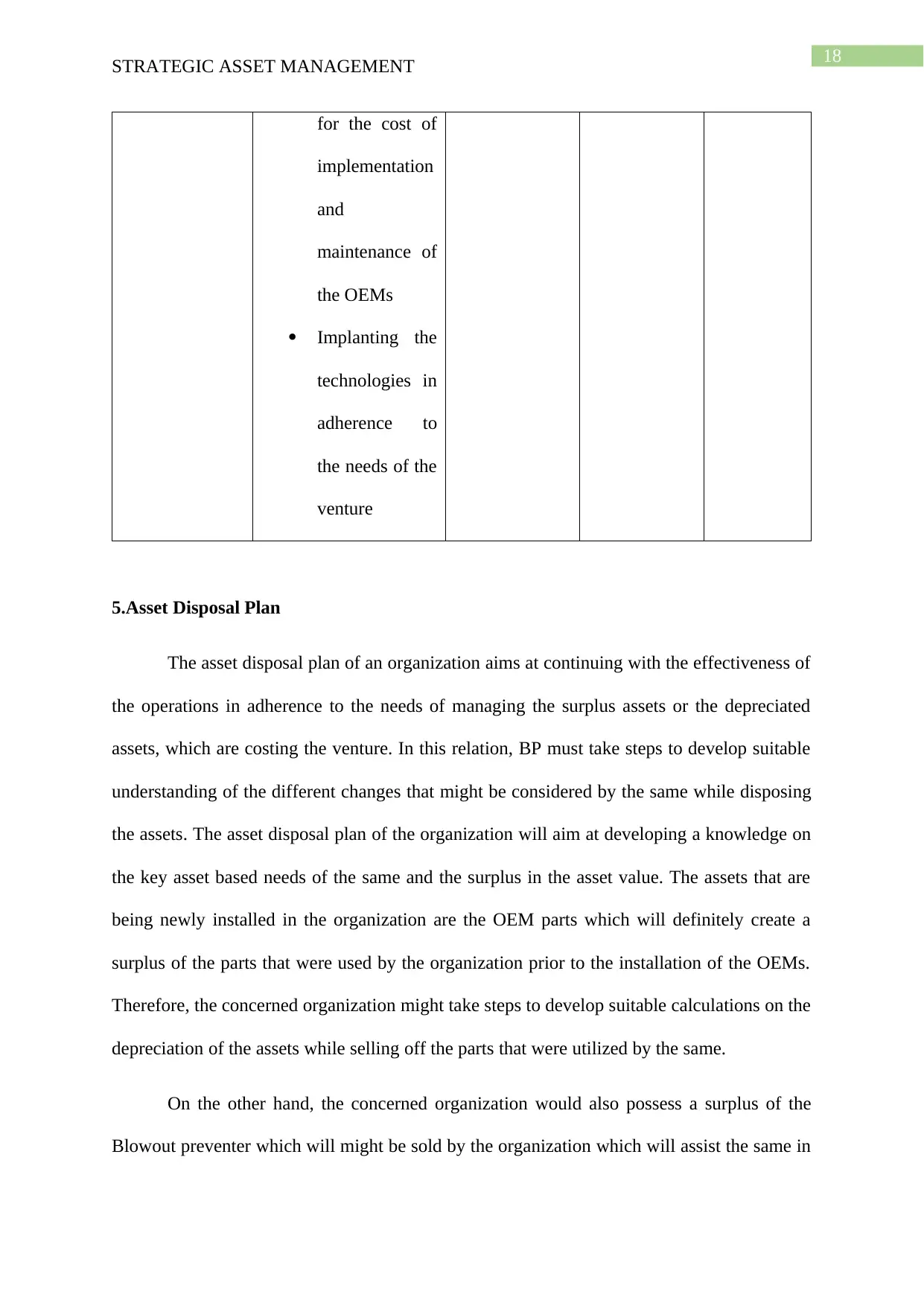
18
STRATEGIC ASSET MANAGEMENT
for the cost of
implementation
and
maintenance of
the OEMs
Implanting the
technologies in
adherence to
the needs of the
venture
5.Asset Disposal Plan
The asset disposal plan of an organization aims at continuing with the effectiveness of
the operations in adherence to the needs of managing the surplus assets or the depreciated
assets, which are costing the venture. In this relation, BP must take steps to develop suitable
understanding of the different changes that might be considered by the same while disposing
the assets. The asset disposal plan of the organization will aim at developing a knowledge on
the key asset based needs of the same and the surplus in the asset value. The assets that are
being newly installed in the organization are the OEM parts which will definitely create a
surplus of the parts that were used by the organization prior to the installation of the OEMs.
Therefore, the concerned organization might take steps to develop suitable calculations on the
depreciation of the assets while selling off the parts that were utilized by the same.
On the other hand, the concerned organization would also possess a surplus of the
Blowout preventer which will might be sold by the organization which will assist the same in
STRATEGIC ASSET MANAGEMENT
for the cost of
implementation
and
maintenance of
the OEMs
Implanting the
technologies in
adherence to
the needs of the
venture
5.Asset Disposal Plan
The asset disposal plan of an organization aims at continuing with the effectiveness of
the operations in adherence to the needs of managing the surplus assets or the depreciated
assets, which are costing the venture. In this relation, BP must take steps to develop suitable
understanding of the different changes that might be considered by the same while disposing
the assets. The asset disposal plan of the organization will aim at developing a knowledge on
the key asset based needs of the same and the surplus in the asset value. The assets that are
being newly installed in the organization are the OEM parts which will definitely create a
surplus of the parts that were used by the organization prior to the installation of the OEMs.
Therefore, the concerned organization might take steps to develop suitable calculations on the
depreciation of the assets while selling off the parts that were utilized by the same.
On the other hand, the concerned organization would also possess a surplus of the
Blowout preventer which will might be sold by the organization which will assist the same in
Paraphrase This Document
Need a fresh take? Get an instant paraphrase of this document with our AI Paraphraser
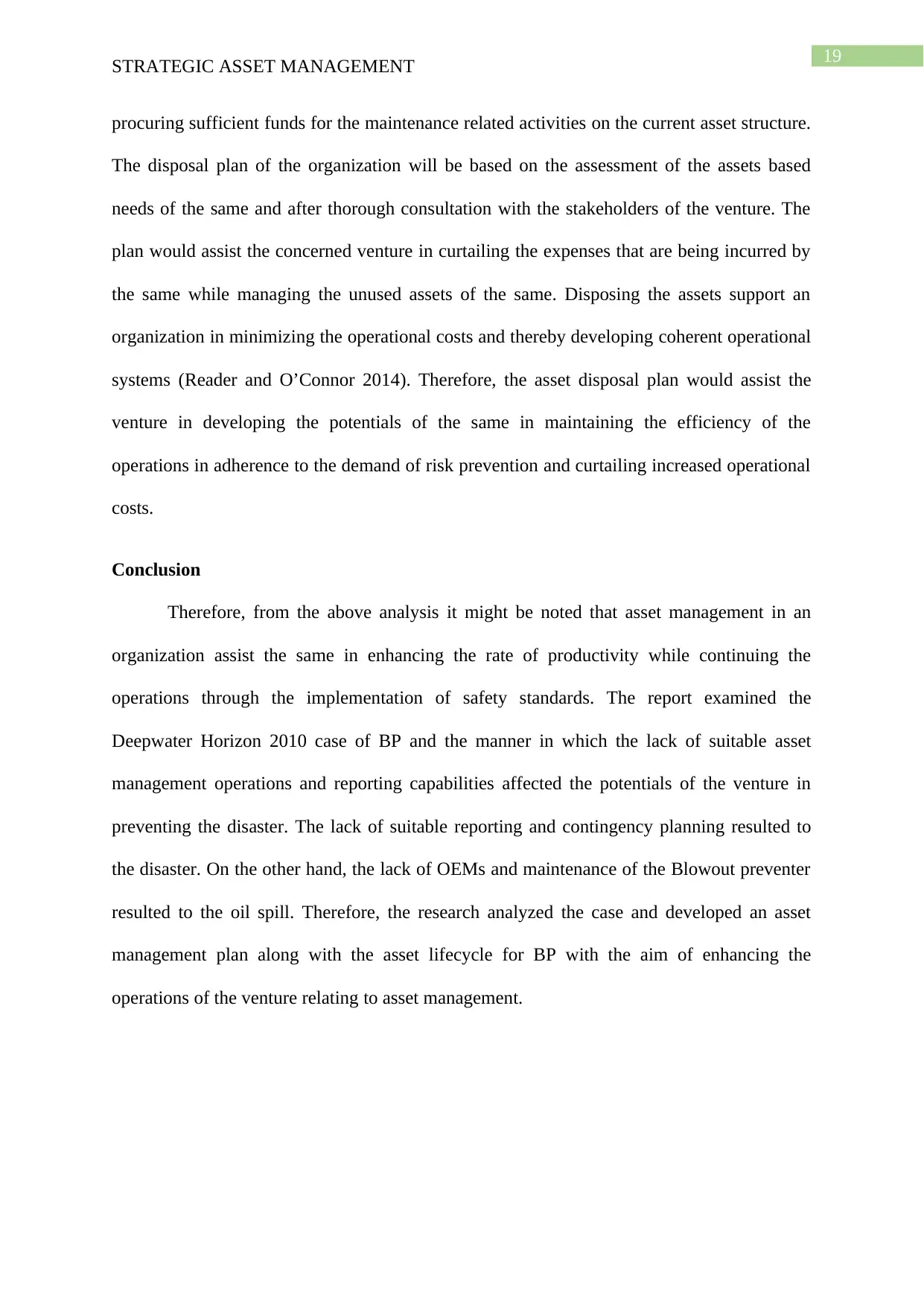
19
STRATEGIC ASSET MANAGEMENT
procuring sufficient funds for the maintenance related activities on the current asset structure.
The disposal plan of the organization will be based on the assessment of the assets based
needs of the same and after thorough consultation with the stakeholders of the venture. The
plan would assist the concerned venture in curtailing the expenses that are being incurred by
the same while managing the unused assets of the same. Disposing the assets support an
organization in minimizing the operational costs and thereby developing coherent operational
systems (Reader and O’Connor 2014). Therefore, the asset disposal plan would assist the
venture in developing the potentials of the same in maintaining the efficiency of the
operations in adherence to the demand of risk prevention and curtailing increased operational
costs.
Conclusion
Therefore, from the above analysis it might be noted that asset management in an
organization assist the same in enhancing the rate of productivity while continuing the
operations through the implementation of safety standards. The report examined the
Deepwater Horizon 2010 case of BP and the manner in which the lack of suitable asset
management operations and reporting capabilities affected the potentials of the venture in
preventing the disaster. The lack of suitable reporting and contingency planning resulted to
the disaster. On the other hand, the lack of OEMs and maintenance of the Blowout preventer
resulted to the oil spill. Therefore, the research analyzed the case and developed an asset
management plan along with the asset lifecycle for BP with the aim of enhancing the
operations of the venture relating to asset management.
STRATEGIC ASSET MANAGEMENT
procuring sufficient funds for the maintenance related activities on the current asset structure.
The disposal plan of the organization will be based on the assessment of the assets based
needs of the same and after thorough consultation with the stakeholders of the venture. The
plan would assist the concerned venture in curtailing the expenses that are being incurred by
the same while managing the unused assets of the same. Disposing the assets support an
organization in minimizing the operational costs and thereby developing coherent operational
systems (Reader and O’Connor 2014). Therefore, the asset disposal plan would assist the
venture in developing the potentials of the same in maintaining the efficiency of the
operations in adherence to the demand of risk prevention and curtailing increased operational
costs.
Conclusion
Therefore, from the above analysis it might be noted that asset management in an
organization assist the same in enhancing the rate of productivity while continuing the
operations through the implementation of safety standards. The report examined the
Deepwater Horizon 2010 case of BP and the manner in which the lack of suitable asset
management operations and reporting capabilities affected the potentials of the venture in
preventing the disaster. The lack of suitable reporting and contingency planning resulted to
the disaster. On the other hand, the lack of OEMs and maintenance of the Blowout preventer
resulted to the oil spill. Therefore, the research analyzed the case and developed an asset
management plan along with the asset lifecycle for BP with the aim of enhancing the
operations of the venture relating to asset management.
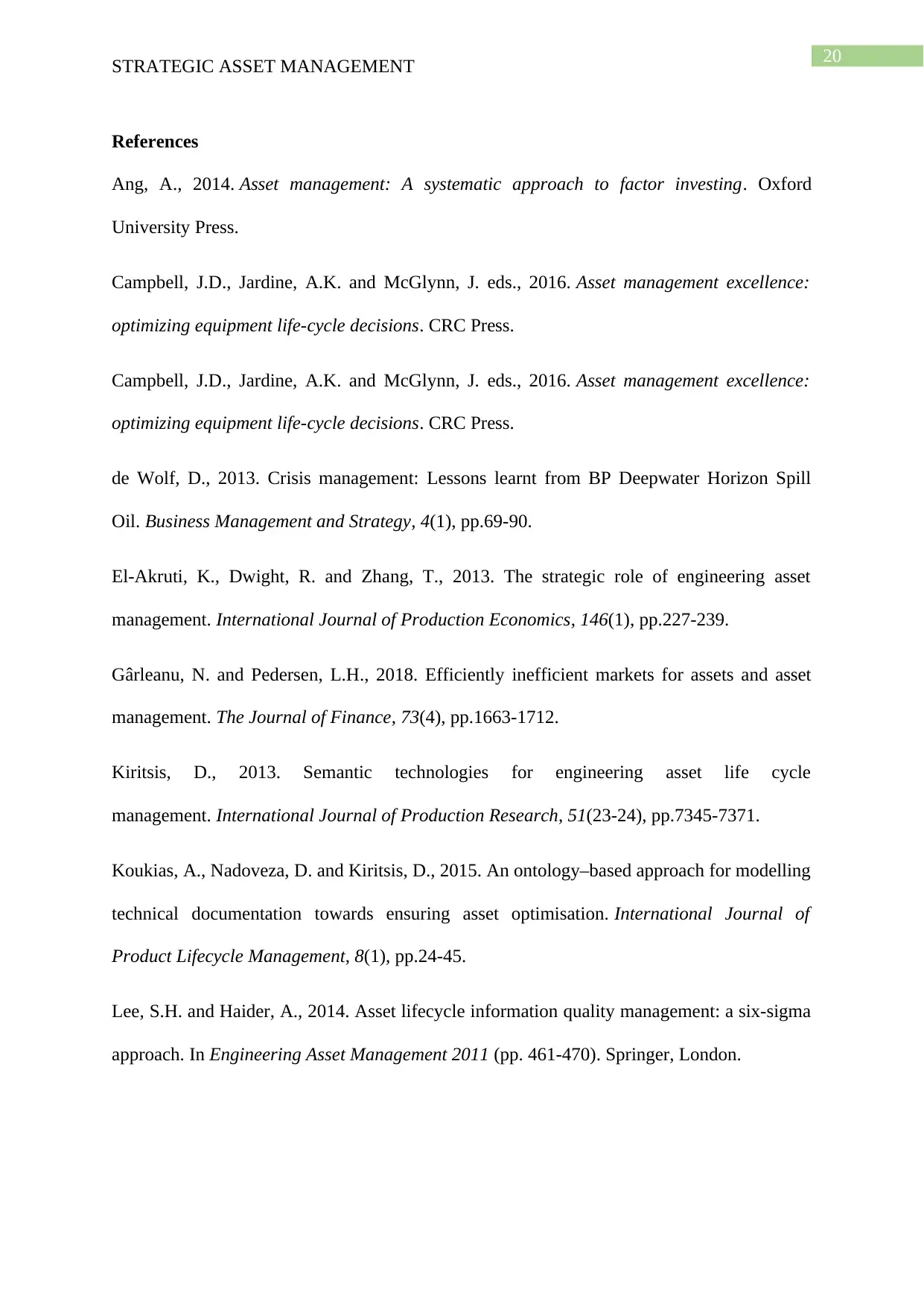
20
STRATEGIC ASSET MANAGEMENT
References
Ang, A., 2014. Asset management: A systematic approach to factor investing. Oxford
University Press.
Campbell, J.D., Jardine, A.K. and McGlynn, J. eds., 2016. Asset management excellence:
optimizing equipment life-cycle decisions. CRC Press.
Campbell, J.D., Jardine, A.K. and McGlynn, J. eds., 2016. Asset management excellence:
optimizing equipment life-cycle decisions. CRC Press.
de Wolf, D., 2013. Crisis management: Lessons learnt from BP Deepwater Horizon Spill
Oil. Business Management and Strategy, 4(1), pp.69-90.
El-Akruti, K., Dwight, R. and Zhang, T., 2013. The strategic role of engineering asset
management. International Journal of Production Economics, 146(1), pp.227-239.
Gârleanu, N. and Pedersen, L.H., 2018. Efficiently inefficient markets for assets and asset
management. The Journal of Finance, 73(4), pp.1663-1712.
Kiritsis, D., 2013. Semantic technologies for engineering asset life cycle
management. International Journal of Production Research, 51(23-24), pp.7345-7371.
Koukias, A., Nadoveza, D. and Kiritsis, D., 2015. An ontology–based approach for modelling
technical documentation towards ensuring asset optimisation. International Journal of
Product Lifecycle Management, 8(1), pp.24-45.
Lee, S.H. and Haider, A., 2014. Asset lifecycle information quality management: a six-sigma
approach. In Engineering Asset Management 2011 (pp. 461-470). Springer, London.
STRATEGIC ASSET MANAGEMENT
References
Ang, A., 2014. Asset management: A systematic approach to factor investing. Oxford
University Press.
Campbell, J.D., Jardine, A.K. and McGlynn, J. eds., 2016. Asset management excellence:
optimizing equipment life-cycle decisions. CRC Press.
Campbell, J.D., Jardine, A.K. and McGlynn, J. eds., 2016. Asset management excellence:
optimizing equipment life-cycle decisions. CRC Press.
de Wolf, D., 2013. Crisis management: Lessons learnt from BP Deepwater Horizon Spill
Oil. Business Management and Strategy, 4(1), pp.69-90.
El-Akruti, K., Dwight, R. and Zhang, T., 2013. The strategic role of engineering asset
management. International Journal of Production Economics, 146(1), pp.227-239.
Gârleanu, N. and Pedersen, L.H., 2018. Efficiently inefficient markets for assets and asset
management. The Journal of Finance, 73(4), pp.1663-1712.
Kiritsis, D., 2013. Semantic technologies for engineering asset life cycle
management. International Journal of Production Research, 51(23-24), pp.7345-7371.
Koukias, A., Nadoveza, D. and Kiritsis, D., 2015. An ontology–based approach for modelling
technical documentation towards ensuring asset optimisation. International Journal of
Product Lifecycle Management, 8(1), pp.24-45.
Lee, S.H. and Haider, A., 2014. Asset lifecycle information quality management: a six-sigma
approach. In Engineering Asset Management 2011 (pp. 461-470). Springer, London.
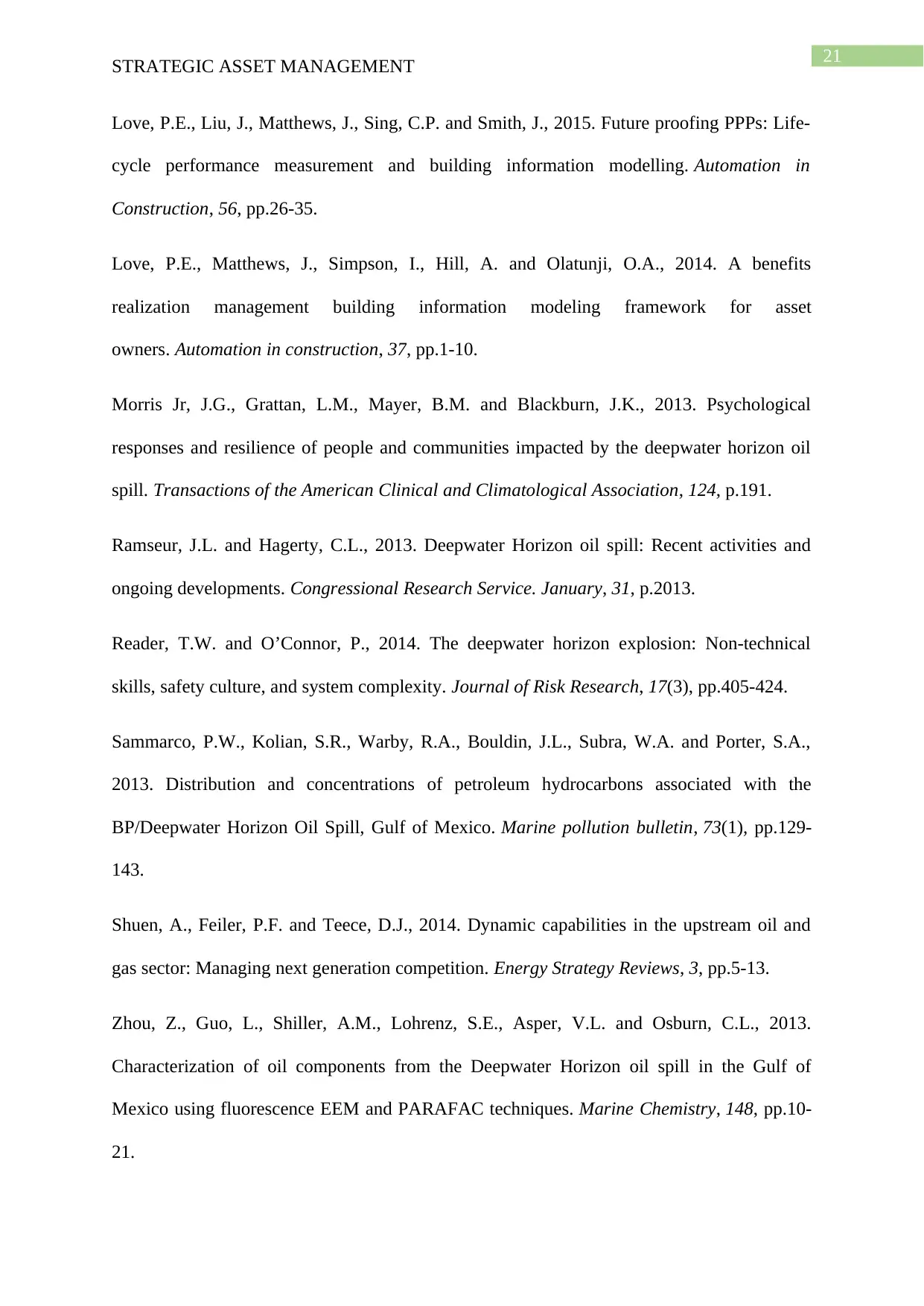
21
STRATEGIC ASSET MANAGEMENT
Love, P.E., Liu, J., Matthews, J., Sing, C.P. and Smith, J., 2015. Future proofing PPPs: Life-
cycle performance measurement and building information modelling. Automation in
Construction, 56, pp.26-35.
Love, P.E., Matthews, J., Simpson, I., Hill, A. and Olatunji, O.A., 2014. A benefits
realization management building information modeling framework for asset
owners. Automation in construction, 37, pp.1-10.
Morris Jr, J.G., Grattan, L.M., Mayer, B.M. and Blackburn, J.K., 2013. Psychological
responses and resilience of people and communities impacted by the deepwater horizon oil
spill. Transactions of the American Clinical and Climatological Association, 124, p.191.
Ramseur, J.L. and Hagerty, C.L., 2013. Deepwater Horizon oil spill: Recent activities and
ongoing developments. Congressional Research Service. January, 31, p.2013.
Reader, T.W. and O’Connor, P., 2014. The deepwater horizon explosion: Non-technical
skills, safety culture, and system complexity. Journal of Risk Research, 17(3), pp.405-424.
Sammarco, P.W., Kolian, S.R., Warby, R.A., Bouldin, J.L., Subra, W.A. and Porter, S.A.,
2013. Distribution and concentrations of petroleum hydrocarbons associated with the
BP/Deepwater Horizon Oil Spill, Gulf of Mexico. Marine pollution bulletin, 73(1), pp.129-
143.
Shuen, A., Feiler, P.F. and Teece, D.J., 2014. Dynamic capabilities in the upstream oil and
gas sector: Managing next generation competition. Energy Strategy Reviews, 3, pp.5-13.
Zhou, Z., Guo, L., Shiller, A.M., Lohrenz, S.E., Asper, V.L. and Osburn, C.L., 2013.
Characterization of oil components from the Deepwater Horizon oil spill in the Gulf of
Mexico using fluorescence EEM and PARAFAC techniques. Marine Chemistry, 148, pp.10-
21.
STRATEGIC ASSET MANAGEMENT
Love, P.E., Liu, J., Matthews, J., Sing, C.P. and Smith, J., 2015. Future proofing PPPs: Life-
cycle performance measurement and building information modelling. Automation in
Construction, 56, pp.26-35.
Love, P.E., Matthews, J., Simpson, I., Hill, A. and Olatunji, O.A., 2014. A benefits
realization management building information modeling framework for asset
owners. Automation in construction, 37, pp.1-10.
Morris Jr, J.G., Grattan, L.M., Mayer, B.M. and Blackburn, J.K., 2013. Psychological
responses and resilience of people and communities impacted by the deepwater horizon oil
spill. Transactions of the American Clinical and Climatological Association, 124, p.191.
Ramseur, J.L. and Hagerty, C.L., 2013. Deepwater Horizon oil spill: Recent activities and
ongoing developments. Congressional Research Service. January, 31, p.2013.
Reader, T.W. and O’Connor, P., 2014. The deepwater horizon explosion: Non-technical
skills, safety culture, and system complexity. Journal of Risk Research, 17(3), pp.405-424.
Sammarco, P.W., Kolian, S.R., Warby, R.A., Bouldin, J.L., Subra, W.A. and Porter, S.A.,
2013. Distribution and concentrations of petroleum hydrocarbons associated with the
BP/Deepwater Horizon Oil Spill, Gulf of Mexico. Marine pollution bulletin, 73(1), pp.129-
143.
Shuen, A., Feiler, P.F. and Teece, D.J., 2014. Dynamic capabilities in the upstream oil and
gas sector: Managing next generation competition. Energy Strategy Reviews, 3, pp.5-13.
Zhou, Z., Guo, L., Shiller, A.M., Lohrenz, S.E., Asper, V.L. and Osburn, C.L., 2013.
Characterization of oil components from the Deepwater Horizon oil spill in the Gulf of
Mexico using fluorescence EEM and PARAFAC techniques. Marine Chemistry, 148, pp.10-
21.
Secure Best Marks with AI Grader
Need help grading? Try our AI Grader for instant feedback on your assignments.

22
STRATEGIC ASSET MANAGEMENT
STRATEGIC ASSET MANAGEMENT
1 out of 23
Related Documents
Your All-in-One AI-Powered Toolkit for Academic Success.
+13062052269
info@desklib.com
Available 24*7 on WhatsApp / Email
![[object Object]](/_next/static/media/star-bottom.7253800d.svg)
Unlock your academic potential
© 2024 | Zucol Services PVT LTD | All rights reserved.


